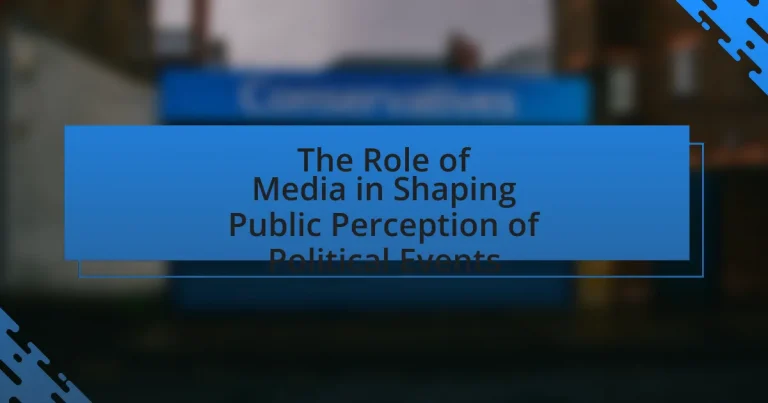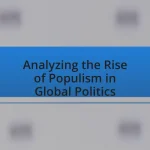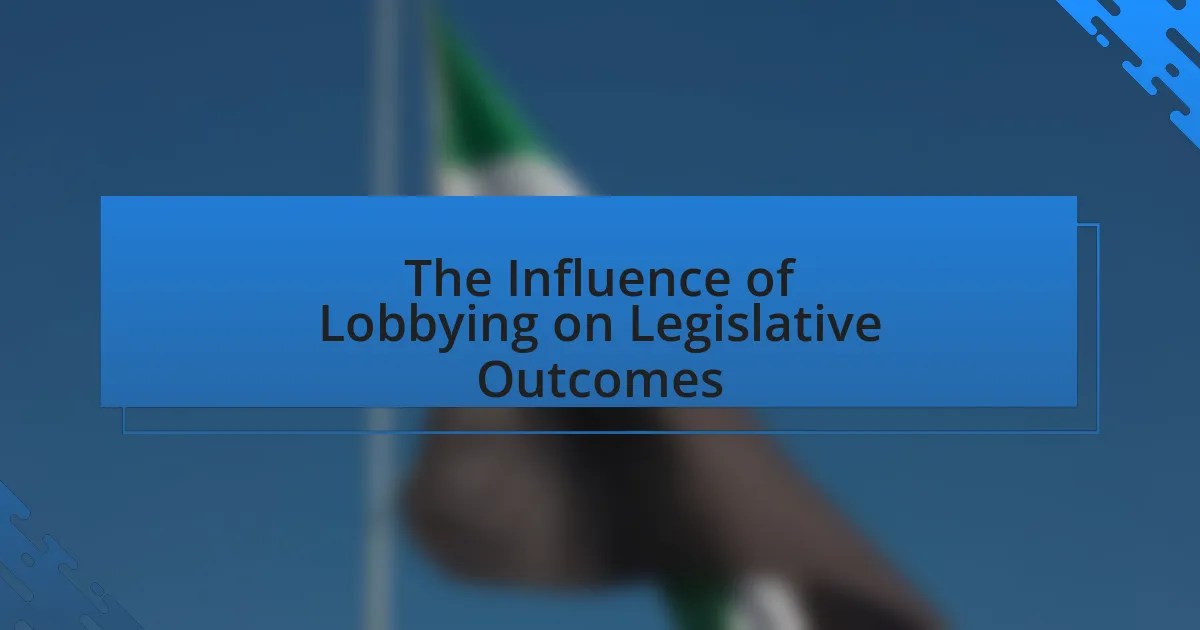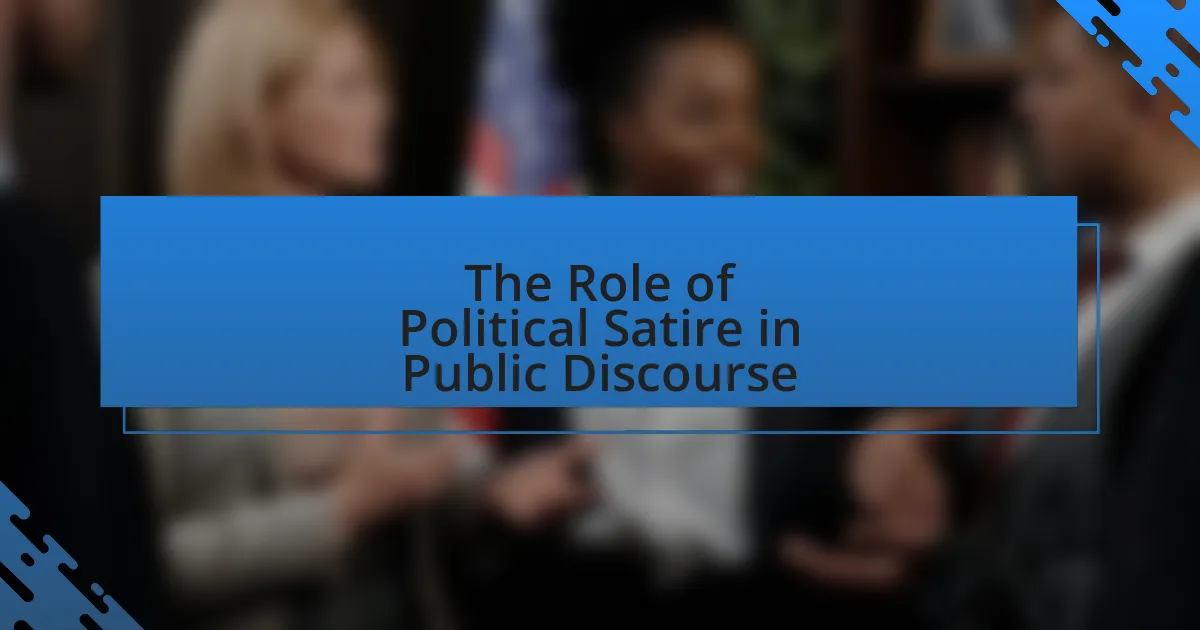The article examines the critical role of media in shaping public perception of political events, highlighting mechanisms such as framing, agenda-setting, and priming. It discusses how different media formats, including traditional, digital, and social media, influence public opinion and political discourse. The article also addresses the impact of audience demographics, such as age and education level, on media consumption and interpretation, as well as the risks associated with misinformation. Additionally, it explores strategies for individuals to critically engage with media coverage and identify bias in political reporting, emphasizing the importance of media literacy in fostering informed public discourse.
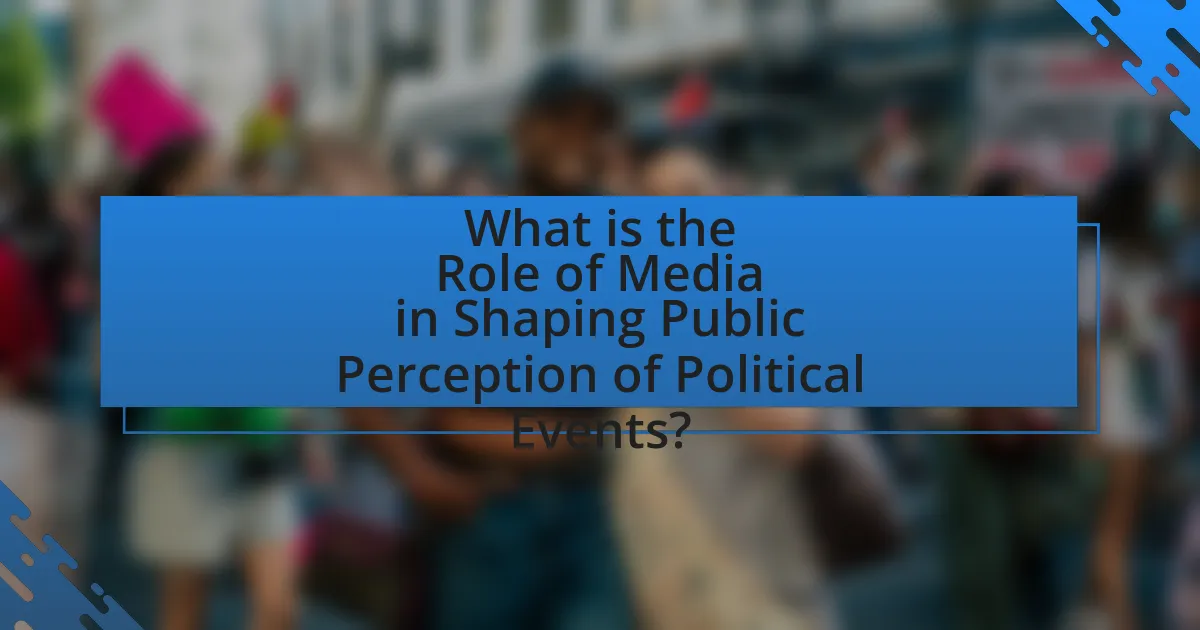
What is the Role of Media in Shaping Public Perception of Political Events?
The media plays a crucial role in shaping public perception of political events by influencing how information is presented and interpreted. Through selective coverage, framing, and agenda-setting, media outlets determine which events are highlighted and how they are contextualized, thereby affecting public opinion. For instance, studies have shown that the framing of political issues can significantly alter audience perceptions; a 2018 study published in the Journal of Communication found that framing immigration as a security threat increased public support for restrictive policies. Additionally, the rise of social media has amplified this effect, allowing for rapid dissemination of information and the potential for misinformation, which can further skew public understanding of political events.
How does media influence public opinion during political events?
Media significantly influences public opinion during political events by shaping narratives, framing issues, and providing information that guides audience perceptions. For instance, studies show that the way news outlets report on political candidates can affect voter attitudes; a 2018 study published in the Journal of Communication found that positive media coverage of a candidate increased their favorability ratings by up to 20%. Additionally, media framing can highlight specific aspects of political events, leading audiences to interpret situations in particular ways, as demonstrated by the framing of protests in various media outlets, which can either garner support or condemnation from the public. Thus, the media’s role in selecting and presenting information is crucial in molding public opinion during political events.
What are the key mechanisms through which media shapes perceptions?
Media shapes perceptions primarily through framing, agenda-setting, and priming. Framing involves presenting information in a particular way that influences how audiences interpret it; for example, the portrayal of political protests as either “riots” or “demonstrations” can significantly alter public perception. Agenda-setting refers to the media’s ability to highlight certain issues over others, thereby influencing what the public considers important; studies show that when media focuses on specific topics, audiences are more likely to perceive those topics as significant. Priming occurs when media exposure affects the criteria by which audiences evaluate political figures or events; for instance, extensive coverage of economic issues can lead voters to prioritize economic performance when assessing a candidate. These mechanisms collectively demonstrate how media can shape public understanding and attitudes toward political events.
How do different media formats impact public perception?
Different media formats significantly impact public perception by influencing how information is presented and consumed. For instance, visual media, such as television and online videos, often evoke stronger emotional responses compared to text-based formats like newspapers or articles, leading to heightened engagement and retention of information. Research by the Pew Research Center indicates that individuals exposed to video content are more likely to remember key messages and share them, thereby amplifying the reach and influence of the information. Additionally, social media platforms, characterized by their interactive nature, allow for immediate feedback and discussion, which can shape public opinion in real-time, as seen during political events like elections where hashtags and trending topics can sway perceptions rapidly.
Why is media representation important in political contexts?
Media representation is crucial in political contexts because it shapes public perception and influences political discourse. Accurate and diverse media representation ensures that various viewpoints are presented, which can affect voter behavior and policy decisions. For instance, studies have shown that media portrayal of political candidates can significantly impact their approval ratings; a 2018 study by the Pew Research Center found that 62% of Americans believe media coverage influences their opinions about political figures. Thus, the way media represents political issues and actors directly affects democratic engagement and public trust in political institutions.
What role does media play in framing political narratives?
Media plays a crucial role in framing political narratives by influencing how events and issues are perceived by the public. Through selective coverage, language choices, and the emphasis placed on certain aspects of a story, media outlets shape the context in which political information is understood. For instance, studies have shown that the framing of immigration issues in news reports can significantly affect public opinion, with different portrayals leading to varying levels of support or opposition to immigration policies. This demonstrates that the media not only informs the public but also actively constructs the narrative around political events, thereby impacting political discourse and public perception.
How does media bias affect public understanding of political events?
Media bias significantly distorts public understanding of political events by shaping narratives that favor specific viewpoints or agendas. This bias can lead to selective reporting, where certain facts are emphasized while others are downplayed or ignored, ultimately influencing how audiences perceive issues. For instance, a study by the Pew Research Center found that individuals who consume news from sources with a particular ideological slant are more likely to hold skewed perceptions of political realities, such as the severity of issues like immigration or healthcare. This selective exposure reinforces existing beliefs and creates echo chambers, further polarizing public opinion and hindering informed discourse.

What are the types of media that influence political perception?
The types of media that influence political perception include traditional media, digital media, social media, and alternative media. Traditional media, such as newspapers, television, and radio, have historically shaped public opinion through news coverage and editorial content. Digital media encompasses online news websites and blogs, which provide immediate access to information and diverse viewpoints. Social media platforms, like Facebook and Twitter, facilitate real-time discussions and allow users to share opinions, significantly impacting political discourse. Alternative media, including independent news outlets and citizen journalism, often challenge mainstream narratives and provide marginalized perspectives. Each of these media types plays a crucial role in shaping how individuals perceive political events and issues.
How do traditional media outlets contribute to public perception?
Traditional media outlets contribute to public perception by framing news stories and influencing the narrative surrounding political events. Through selective coverage, traditional media can highlight specific issues, shape public discourse, and impact audience opinions. For example, a study by the Pew Research Center found that the way news is presented—such as the choice of headlines and the emphasis on certain facts—can significantly affect how the public interprets political events. This framing can lead to varying perceptions among different demographic groups, demonstrating the media’s powerful role in shaping societal views.
What are the strengths and weaknesses of print media in political reporting?
Print media in political reporting has strengths such as in-depth analysis and credibility, while its weaknesses include limited immediacy and declining readership. The strength of in-depth analysis allows print media to provide comprehensive coverage of political issues, often supported by investigative journalism, which can enhance public understanding. For instance, the Watergate scandal was extensively reported in print, leading to significant political consequences. Credibility is another strength, as established newspapers often have rigorous editorial standards, which can foster trust among readers. However, the weakness of limited immediacy means that print media cannot compete with digital platforms in delivering real-time news updates, which can lead to a lag in public awareness of unfolding events. Additionally, declining readership due to the rise of digital media has resulted in reduced advertising revenue, impacting the financial viability of print outlets and their ability to invest in quality political reporting.
How does television shape political narratives differently than print?
Television shapes political narratives differently than print by utilizing visual and auditory elements to create immediate emotional engagement, while print relies on textual information that requires deeper cognitive processing. Television’s use of imagery, sound, and real-time reporting can evoke strong emotional responses, influencing viewers’ perceptions and opinions more rapidly than the analytical engagement typically fostered by print media. For instance, studies have shown that televised political debates can significantly sway public opinion due to the visual presentation of candidates, as evidenced by the 1960 Kennedy-Nixon debate, where Kennedy’s confident appearance on screen contrasted with Nixon’s less favorable visual presentation, impacting voter perceptions.
What impact do digital and social media have on political events?
Digital and social media significantly influence political events by shaping public discourse and mobilizing political action. These platforms enable rapid dissemination of information, allowing political messages to reach large audiences instantly. For instance, during the Arab Spring, social media was pivotal in organizing protests and sharing real-time updates, demonstrating its power in facilitating political change. Additionally, studies show that social media can sway public opinion; a 2018 Pew Research Center report indicated that 62% of Americans get news from social media, highlighting its role in informing citizens about political issues. Thus, digital and social media serve as crucial tools in both the communication and mobilization aspects of political events.
How do social media platforms alter the landscape of political communication?
Social media platforms significantly alter the landscape of political communication by enabling direct interaction between politicians and the public, bypassing traditional media gatekeepers. This shift allows for real-time dissemination of information, fostering greater engagement and participation in political discourse. For instance, during the 2016 U.S. presidential election, candidates utilized platforms like Twitter and Facebook to communicate directly with voters, resulting in a more personalized and immediate form of political engagement. Additionally, studies indicate that social media can amplify political polarization, as users often engage with content that aligns with their existing beliefs, thus shaping public perception and influencing electoral outcomes.
What are the risks associated with misinformation on digital platforms?
Misinformation on digital platforms poses significant risks, including the erosion of public trust, the polarization of opinions, and the potential for real-world harm. The spread of false information can lead to confusion and skepticism towards credible sources, undermining the integrity of democratic processes. For instance, a study by the Pew Research Center found that 64% of Americans believe that misinformation has a major impact on their ability to understand current events. Additionally, misinformation can incite violence or unrest, as seen in various instances where false narratives have fueled protests or riots. These risks highlight the critical need for media literacy and fact-checking to mitigate the adverse effects of misinformation in shaping public perception of political events.
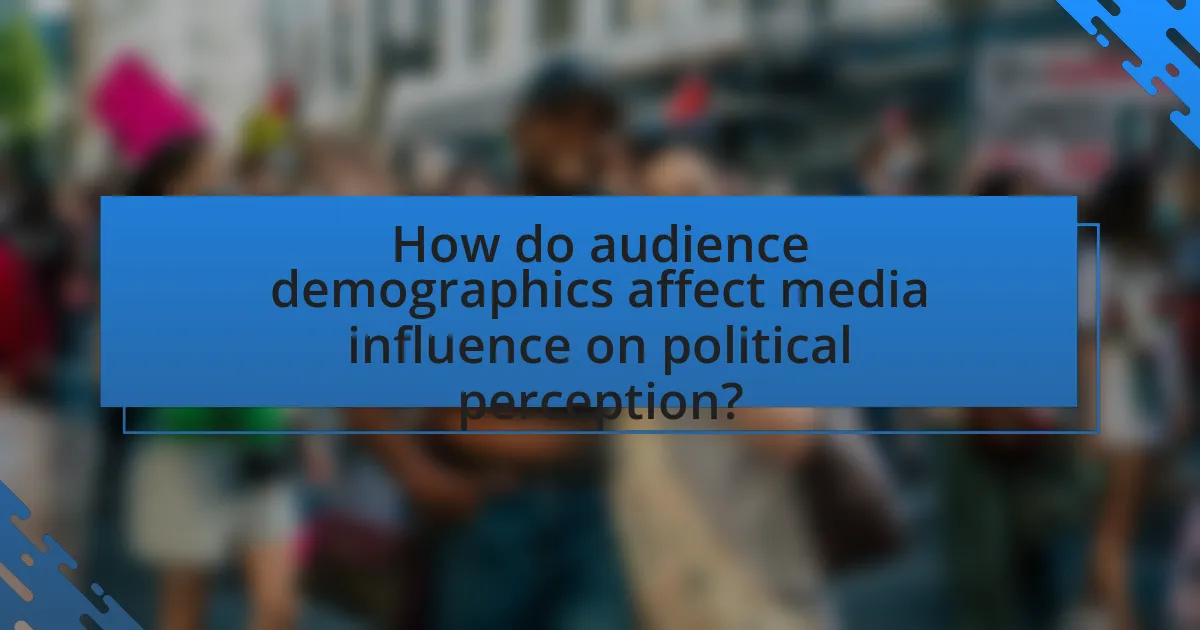
How do audience demographics affect media influence on political perception?
Audience demographics significantly affect media influence on political perception by shaping the way individuals interpret and engage with political content. Factors such as age, race, education level, and socioeconomic status determine preferences for specific media outlets and the types of narratives that resonate with different groups. For instance, younger audiences may prefer digital platforms that emphasize social media engagement, while older demographics might rely on traditional news sources, leading to divergent political views based on the information consumed. Research indicates that demographic groups often have varying levels of trust in media sources, which can further influence their political beliefs and perceptions. A study by the Pew Research Center found that 62% of adults aged 18-29 trust social media for news, compared to only 27% of those aged 65 and older, illustrating how age-related differences in media consumption can shape political understanding and engagement.
What role does age play in media consumption and political views?
Age significantly influences media consumption and political views, with younger individuals typically favoring digital platforms and social media, while older demographics often prefer traditional media such as television and newspapers. Research indicates that younger audiences are more likely to engage with news through social media channels, which can lead to exposure to diverse political opinions and a greater likelihood of participating in political discourse. Conversely, older adults tend to consume news from established sources, which may reinforce traditional political views and limit exposure to alternative perspectives. A study by the Pew Research Center found that 84% of adults aged 18-29 get news from social media, compared to only 45% of those aged 65 and older, highlighting the generational divide in media consumption habits and its impact on political engagement.
How do different age groups interpret political messages from media?
Different age groups interpret political messages from media in distinct ways due to varying levels of media literacy, life experiences, and social contexts. Younger audiences, particularly those aged 18-29, often engage with political content through social media platforms, leading to a preference for visual and interactive formats, which can result in a more emotional and immediate response to political issues. In contrast, middle-aged individuals, typically aged 30-49, tend to consume news through traditional media outlets, such as television and newspapers, which may foster a more analytical approach to political messages, emphasizing context and depth. Older adults, aged 50 and above, often rely on established news sources and may prioritize credibility and trustworthiness, leading to a more cautious interpretation of political messages. Research by the Pew Research Center indicates that younger individuals are more likely to encounter misinformation online, which can skew their understanding of political events, while older adults are more susceptible to confirmation bias, reinforcing pre-existing beliefs.
What are the implications of demographic differences for media strategies?
Demographic differences significantly influence media strategies by necessitating tailored content and distribution methods to effectively engage diverse audiences. For instance, age, gender, ethnicity, and socioeconomic status shape preferences for media consumption, requiring strategies that resonate with specific demographic groups. Research indicates that younger audiences prefer digital platforms, while older demographics may favor traditional media, highlighting the need for a multi-channel approach. Additionally, cultural backgrounds impact the interpretation of messages, making it essential for media strategies to incorporate culturally relevant narratives to foster connection and understanding. This alignment with demographic characteristics enhances audience engagement and improves the effectiveness of communication in shaping public perception of political events.
How does education level influence media interpretation of political events?
Education level significantly influences media interpretation of political events by shaping individuals’ critical thinking skills and their ability to analyze information. Higher education often correlates with enhanced analytical skills, allowing individuals to critically assess media narratives and recognize biases. Research indicates that individuals with advanced degrees are more likely to seek diverse sources of information and engage in deeper analysis of political content, leading to a more nuanced understanding of events. For instance, a study published in the Journal of Communication found that college-educated individuals are better at identifying misinformation and understanding complex political issues compared to those with lower educational attainment. This disparity in media interpretation can lead to differing perceptions of political events, where educated individuals may challenge mainstream narratives and seek out alternative viewpoints, thereby influencing public discourse.
What are the differences in media literacy among various educational backgrounds?
Individuals with higher educational backgrounds typically exhibit greater media literacy compared to those with lower educational attainment. Research indicates that individuals with advanced degrees are more adept at critically analyzing media content, discerning bias, and identifying misinformation. For instance, a study by the Pew Research Center found that college graduates are more likely to evaluate the credibility of news sources and understand the implications of media framing in political contexts. In contrast, individuals with lower educational levels often struggle with these skills, leading to increased susceptibility to misinformation and a less nuanced understanding of political events. This disparity highlights the significant role that education plays in shaping media literacy and, consequently, public perception of political issues.
How does education shape critical thinking about media content?
Education enhances critical thinking about media content by equipping individuals with analytical skills necessary to evaluate information sources effectively. Through structured curricula, students learn to assess the credibility of media outlets, recognize biases, and differentiate between fact and opinion. Research indicates that individuals with higher education levels are more adept at identifying misinformation and understanding media framing, which is crucial in the context of political events. For instance, a study by the Pew Research Center found that 64% of adults with a college degree reported being more confident in their ability to discern credible news sources compared to those with lower educational attainment. This demonstrates that education plays a vital role in fostering a discerning public capable of navigating complex media landscapes.
What strategies can individuals use to critically engage with media coverage of political events?
Individuals can critically engage with media coverage of political events by employing strategies such as cross-referencing multiple news sources, analyzing the language and framing used in reports, and being aware of potential biases. Cross-referencing multiple news sources allows individuals to compare different perspectives and identify inconsistencies, which is crucial given that a 2020 Pew Research study found that 62% of Americans believe news organizations tend to favor one side. Analyzing the language and framing helps individuals recognize how certain words or phrases can influence perception; for instance, the use of “reform” versus “cut” can shape public opinion on policy changes. Additionally, being aware of potential biases, such as ownership of media outlets or political affiliations, enables individuals to assess the reliability of the information presented. These strategies collectively empower individuals to form well-rounded opinions based on a comprehensive understanding of the media landscape.
How can media consumers identify bias in political reporting?
Media consumers can identify bias in political reporting by analyzing the language, framing, and sources used in the coverage. Language that is emotionally charged or loaded can indicate bias, as it may aim to sway opinion rather than present facts. For example, terms like “radical” versus “reformist” can shape perceptions of political figures. Additionally, the framing of issues—how a story is presented—can reveal bias; for instance, focusing on negative aspects of one political party while ignoring similar issues in another can skew public perception. Furthermore, examining the sources cited in reporting is crucial; reliance on partisan sources or a lack of diverse viewpoints can signal a biased narrative. Studies, such as those conducted by the Pew Research Center, have shown that media outlets often exhibit partisan leanings, which can influence the portrayal of political events.
What practices can enhance critical analysis of media messages?
Practices that can enhance critical analysis of media messages include media literacy education, questioning the source and intent of the message, and analyzing the language and visuals used. Media literacy education equips individuals with the skills to critically evaluate media content, fostering an understanding of bias and perspective. Questioning the source involves assessing the credibility and reliability of the information provider, which is crucial in an era of misinformation. Analyzing language and visuals helps to uncover underlying messages and emotional appeals, allowing for a deeper understanding of how media shapes perceptions. These practices are supported by research indicating that individuals who engage in critical media analysis are better equipped to discern fact from opinion and recognize manipulative tactics in media.
